Indian restaurant madras curry is one of the great ones. Madras curry is on every single restaurant menu for a reason. It’s absolutely delicious.
It’s on the hotter end of the scale. A spicy curry. It can even be a really spicy curry. Some restaurants go a little overboard I find. I like blazing hot madras curry. But not everybody does.
So this version isn’t so hot – medium spicy really. That’s the nice thing about cooking it yourself. You control the heat.
Like it blazing hot? Add more kashmiri chili powder or use one the hotter Indian chili powders. Want your kids to eat it? Roll the kashmiri chili back a bit. It’s up to you.
This is how they do it in restaurants
This madras curry is done in the restaurant style. Like you get when you eat out. Pretty much exactly. It’s all about the prep. Cooking it takes 10 minutes.
Restaurants don’t have big pots of curry sitting around hoping somebody will come and order it. They cook to order.
It’s totally different from home style cooking. Homestyle is about low and long braises. Restaurant style is about speed and efficiency. But with lots of flavour.
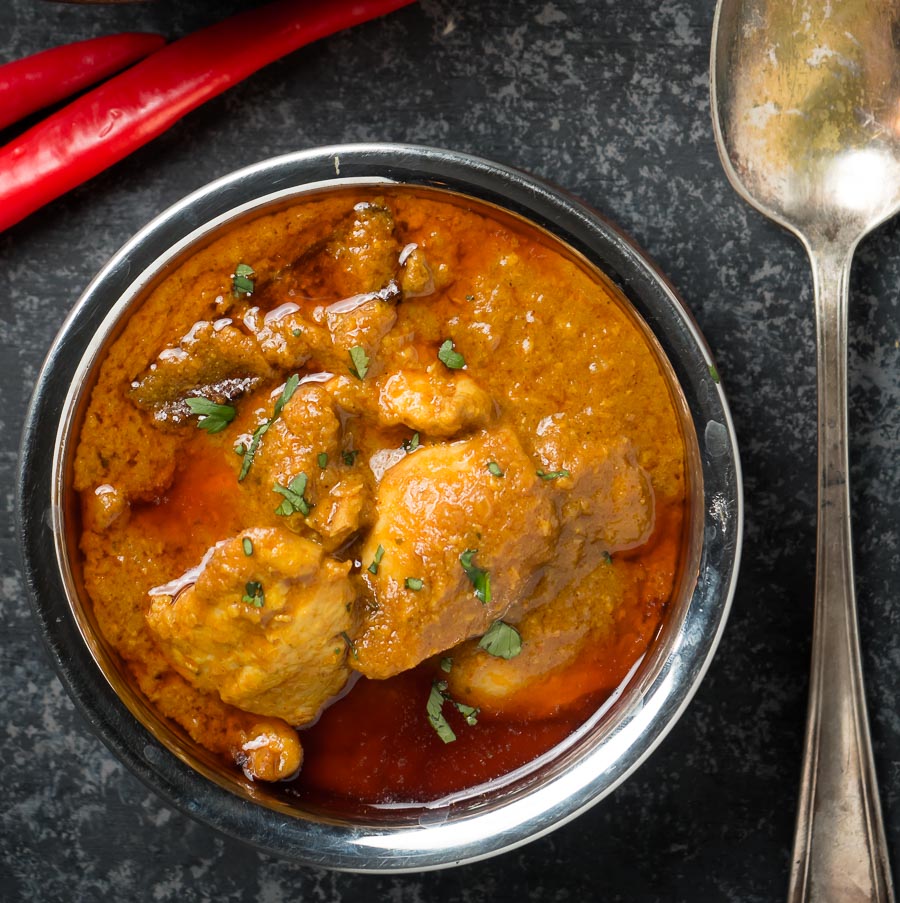
Curry base is the secret
Curry base is a game changer. It’s the way they do it. The foundation of Indian restaurant style cooking. Amazing stuff.
Indian curries generally rely on caramelized onions. That’s what makes them what they are. You need to get that into your dish. And curry base is how restaurants do it. For madras curry. For pretty much all curries.
There’s not much to curry base. It’s basically a whole lot of boiled onions with some flavouring. Tastes like a weak onion curry soup. Bland.
You’d never guess that something so bland can become so good. That’s where the technique comes in.
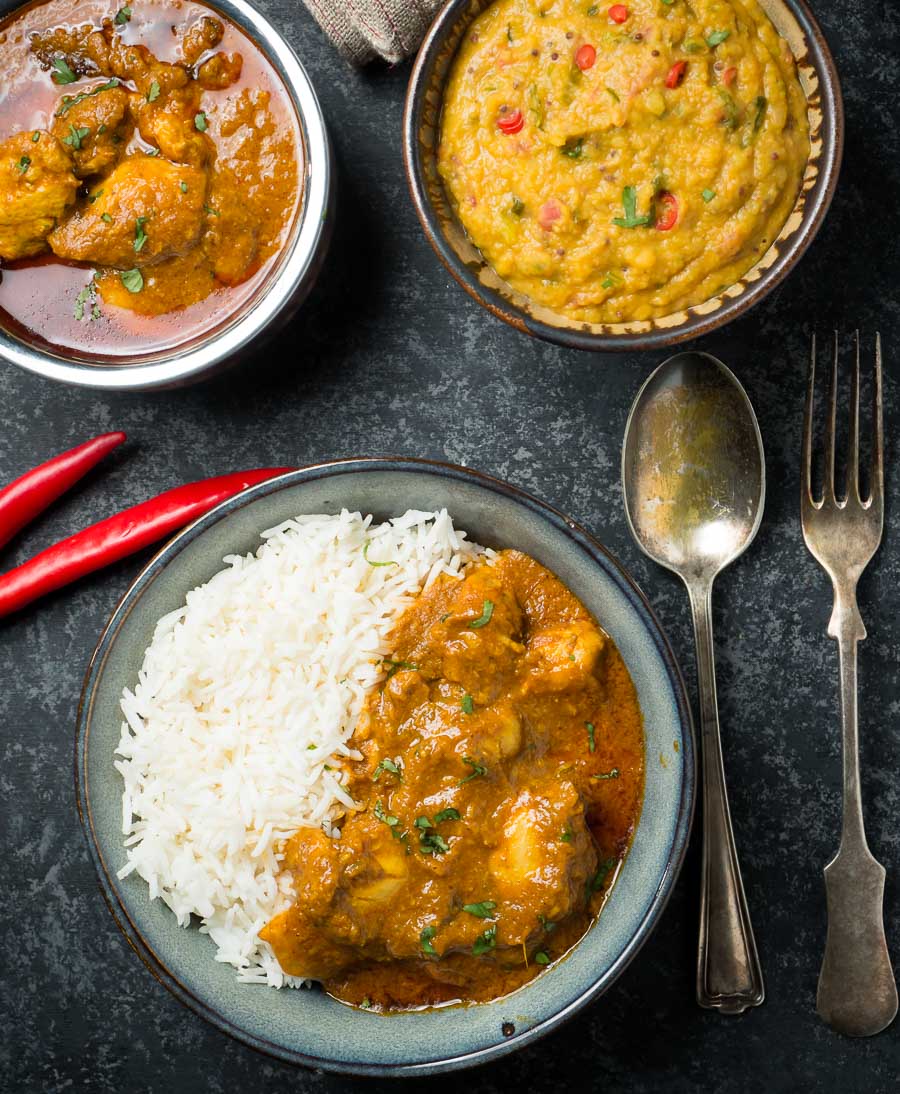
High heat and enough oil makes Indian restaurant madras curry work
The key to making this work is heat. High heat. At the right time. When the curry base hits the pan you want it caramelize. Fast.
It’s a balancing act. The oil can’t be too hot when you bloom the spices. They will burn. Medium heat. Garlic ginger paste goes in next. Tomato after that.
Once you have some wet ingredients in your pan your spices are safe. That’s when you crank it. High heat.
Curry base goes in a bit at a time. You don’t want to cool your pan down too much. Maybe half a ladle at first. Then a full ladle. Then the rest. Somehow it works if you do that.
Read the Indian restaurant curry technique guide
There’s a post that covers the technique and the ingredients you need here. Do yourself a favour. Read it. It will help you understand what you are trying to do.
The recipe below does cover madras curry accurately. If you’ve made a few curries in this style you should have no problem. But if you are just getting started read the guide. It makes things so much easier.
Do your prep before you get started. Make your curry base and have some heated and ready to go. Pre-cook your meat. Measure out your ingredients. Have everything at hand. Put on some old clothes – making restaurant curries is messy stuff.
Watch the video
Chicken madras doesn’t have to be chicken
Almost all the restaurant style curries on glebekitchen can be made how you like. This is a chicken madras. But you can make it with lamb or beef just as easily. You can even make it with chickpeas or masoor dal for a vegetarian option.
Chicken madras is my favourite but lamb is a close second. And a madras curried dal is third. That’s me. You can do what you want. Make this your madras curry. Whatever you want. Just make it.
Madras curry is a spicy dish that’s sure to please. At the top of my list. If you are a fan this is for you. If you haven’t tried it before now is the time.
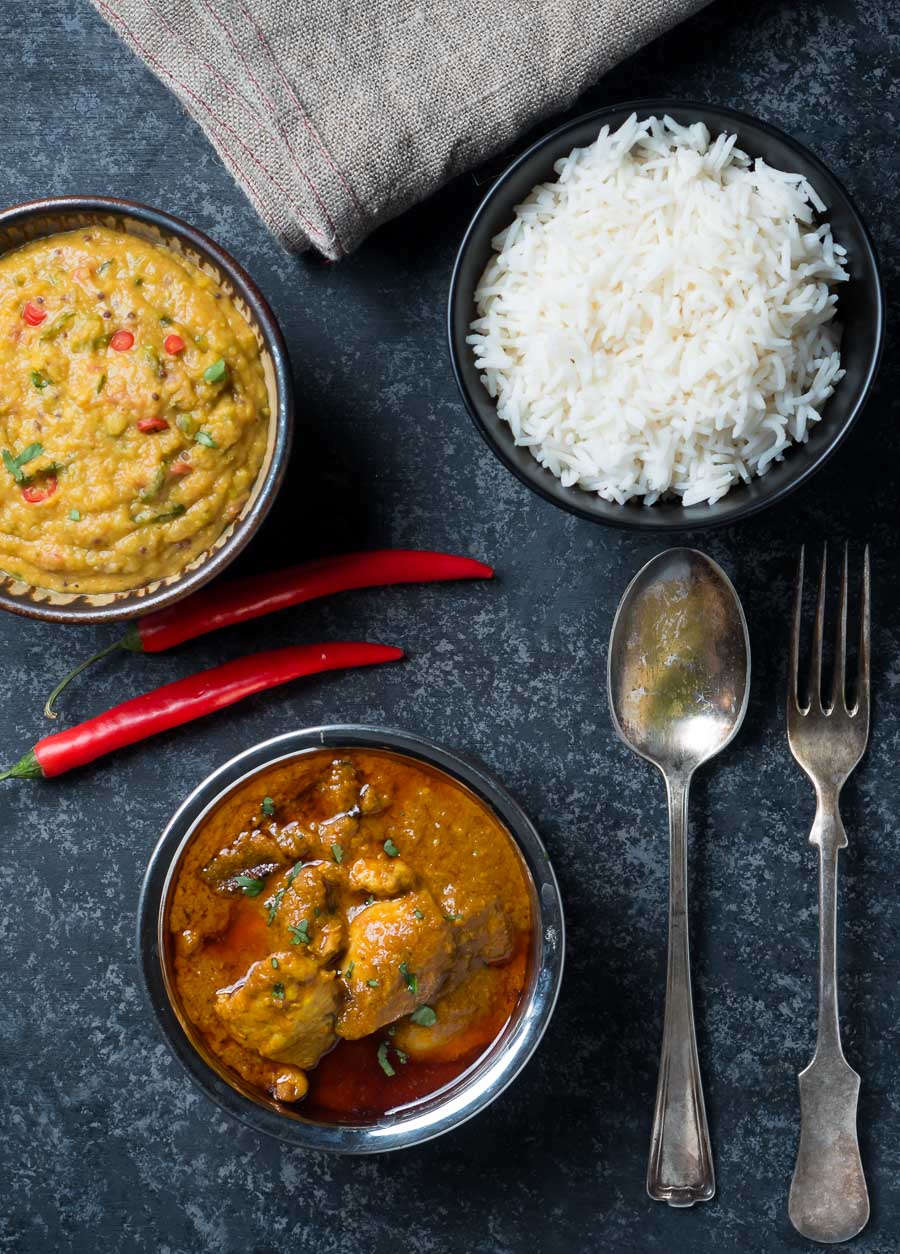
indian restaurant madras curry
Ingredients
The spice mix
- 1 tsp indian restaurant spice mix or curry powder – recipe link below
- 2 tsp hot madras curry powder or use more indian restaurant mix powder if you don’t have any madras curry powder
- 1 tsp kashmiri chili powder or 1/4 tsp cayenne mixed with 3/4 tsp paprika
- 1/2 tsp kasoor methi – dried fenugreek leaves
- 1/2 tsp kosher salt
The curry ingredients
- 4 Tbsp oil
- 2 inch piece of cassia bark or cinnamon stick
- 2 Tbsp onions minced
- 1 Tbsp garlic/ginger paste – recipe link below
- 1 Tbsp tomato paste with enough water to dilute to the consistency of pasatta
- 15 oz curry base – recipe link below
- 10-12 oz pre-cooked chicken or lamb
- 1 Tbsp coconut milk powder in enough water to get to coconut milk consistency (optional)
- 1 tsp fresh lemon juice – about 1/6 of a lemon
Instructions
- Make the spice mix.
- Dilute the tomato paste with enough water to get to the consistency of passata.
- Dilute your coconut milk powder enough with water to get it to the consistency of coconut milk.
- Heat your frying pan (don’t use non-stick) briefly over medium heat. Add the oil.
- When the oil starts to shimmer add the cinnamon stick. Toss is around the pan for about 15 seconds until bubbles start to form around it. It may crackle a bit.
- Add the onions and stir constantly until the edges of the onions start to brown. This takes about a minute.
- Next comes the garlic ginger paste. Add it into the pan and cook it, stirring constantly, until it stops sputtering.
- Turn down the heat and add the spice mix. This is the critical step. Stir it constantly for 30 seconds. If it starts to darken lift the pan off the heat. You want the spice mix to cook in the oil but not burn.
- Turn the heat up to medium high. This is important. The heat is what caramelizes the onion base and gives the curry it’s Indian restaurant flavour. As you become more comfortable with this technique try pushing it. Add the diluted tomato paste and stir until bubbles form (the oil will likely separate). This takes around 30 seconds to one minute depending on the heat.
- Add 3 oz of curry base. Stir until bubbles form (little craters really), around 30 seconds. Think lively boil. Watch the edges of the pan. The curry can stick here. Sticking is OK. Just scrape it back into the base. Burning is bad.
- Now add 6 oz of curry base and stir briefly. Let it cook until the bubbles form again. This takes 1-2 minutes.
- Add the rest of the curry base and let cook until the bubbles form. Add the lemon and diluted coconut milk powder. Turn the heat down to low and add the pre-cooked lamb, beef or chicken.
- Let the curry simmer for about 5 minutes. If it gets too thick add a bit more curry base. Don’t add water.
- Garnish with a bit of chopped fresh cilantro and serve.

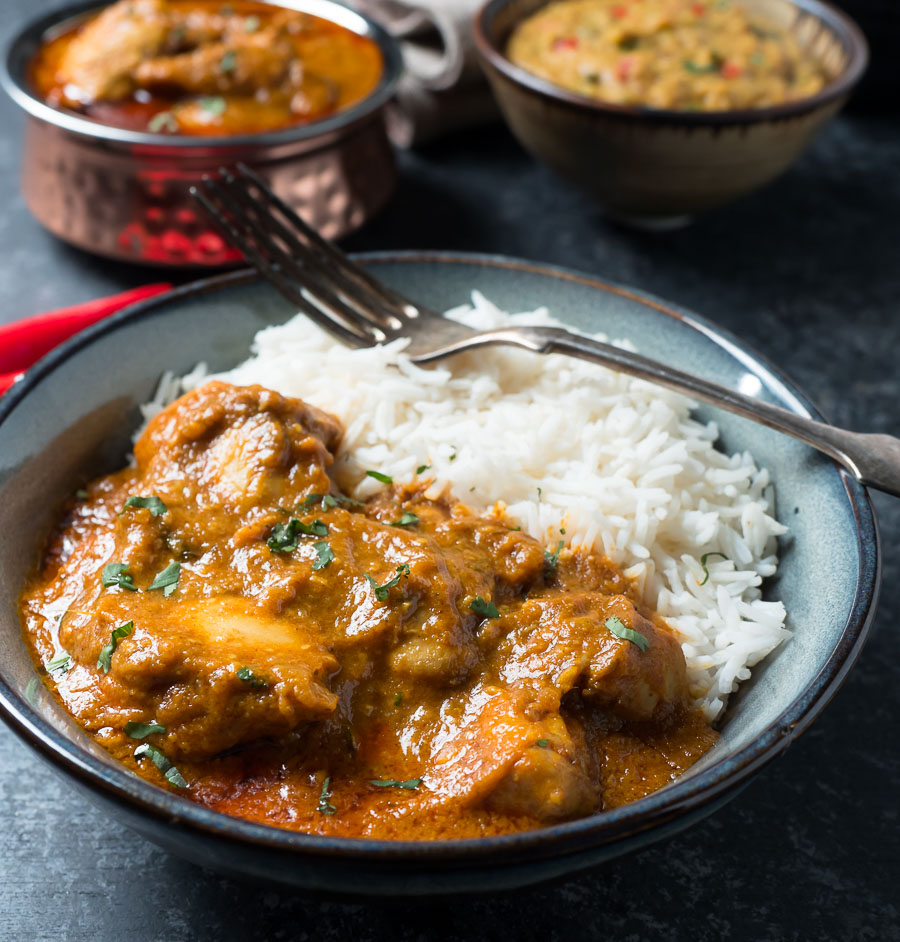
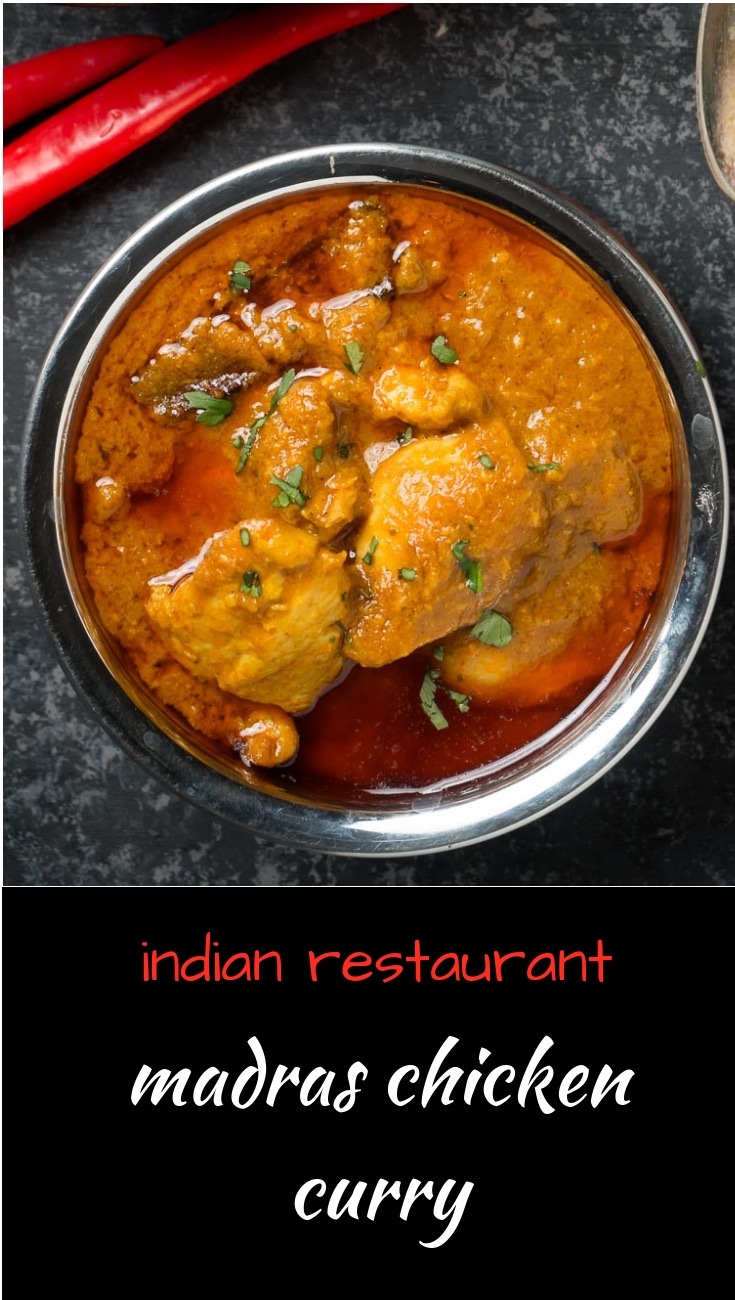
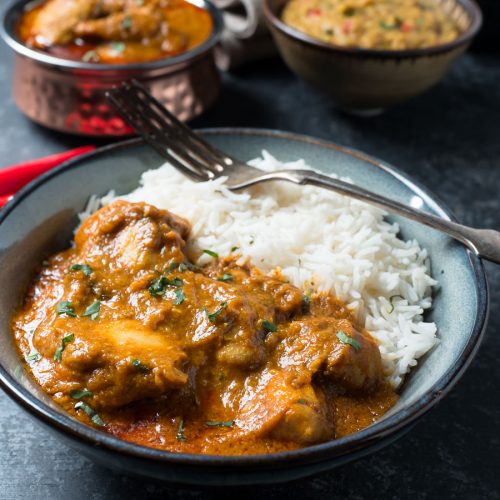
I’ve tried so hard, so many times to make an authentic ‘Indian’ curry and failed. I read everything you wrote, followed your instructions to the letter and…. OMG!!!!!! What an absolute triumph. My cup sizes of water were a bit big initially when making the curry base but once I adjusted that? Best curry I have EVER tasted. My wife just stood there open mouthed in amazement when she tasted it. I loved all the preparation, how everything came together and the authenticity of the taste was exact. I felt compelled to let you know and offer my heartfelt thanks, I am truly grateful. Kind regards, Stephen Ward. (Wales, UK)
I’m delighted to hear that! Now you know all the techniques you are unstoppable. I can’t wait to hear how your future curries turn out.
Hi Romain,
Excellent collection of recipes here. I recently did the dhansak and loved it. One quick question: why use tomato paste and dilute to passata consistency rather than just use passata? Same question regarding coconut powder instead of coconut milk.
Many thanks!
Thank you for saying so!
It’s a matter of portion and convenience really. Tomato paste keeps for a long time in the fridge and takes up little room. Opening a jar of passata is a bit of a commit for a couple tablespoons. Same goes for coconut milk. I do use coconut milk sometimes when I have it around.
Hi, just making base sauce for the first time and have just realised(been cooking for 45
Minutes) that I added 1 and half tablespoons instead of teaspoons of salt and turmeric
Should I just throw away and start again or can I somehow save it?
Maybe not add salt or turmeric to any curry recipes?
Thankyou
The salt will be fine. Just don’t add the salt in the recipe and then adjust at the end if needed. You’ve added roughly an extra 4 teaspoons of salt and recipes usually call for 1/2 tsp so for 8 servings it works out about even.
Turmeric I have no idea. That’s a lot of turmeric. Might be a bit odd tasting, might be fine. Might be completely overpowering. You could try one curry recipe without adding the protein and see what you get. Would be good practice cooking restaurant style in any case.
Brilliant !!! I have bought dozens of cook books trying to replicate my local restaurant curry without success but if you follow this recipe exactly to the page it is actually better. I prefer a whole large 2” fresh red chilli wafer thinly sliced added in at the same time with the spice mix, as too much chilli powder to get a hot madras is bitter and doesn’t digest well, but great recipe thank you for posting ??
Glad you found my little blog! This is why I do what I do! I looked for years as well.
Just made this curry.
Amazing and I thought quite easy, time consuming but fairly straightforward.
Cannot thank you enough
Rob
Now you understand Indian restaurant technique you can make anything!
great post thank you. one query from a newbie cook do we remove the cardamon stick/bits at some stage?
You can remove them when serving if you want. I usually just eat around them. Entirely up to you.
This may be the single best source for authentic indian curry on the internet. Great job, now I have a reason to buy a kitchen scale!
Wow. Thanks!
How do I thicken the sauce ? Do I just keep simmering to reduce
If you need to thicken the sauce my guess is that you didn’t push the boil/fry of the curry base hard enough when you cooked the curry. Please watch the video for an idea of how hard it needs to boil.
If you’ve made a curry and it’s too thin then yes, simmer the sauce to reduce but be careful not to overcook the protein.
Can I ask why it says (don’t use non stick) about the pan? It’s all I’ve got and I’m about to make this tonight.
Of course you can ask:-)
This technique relies on what is called the Maillard reaction and to a lesser extent caramelization of onions to give the curry its flavour. Basically heat plus sugars plus amino acids react to generate a whole lot of flavour compounds. Some sticking seems to intensify the flavours and that sticking doesn’t happen with a teflon coated pan. Think of making a homestyle curry. The first step is almost always to deeply brown the onions. It’s the same basic idea although much, much faster when cooking restaurant style.
Another example of this effect happens when you pan fry a steak. You’ll never get the steak to brown like you do in an uncoated pan. That brown stuff on the steak is Maillard.
It will still be curry if you use non-stick. Just possibly not as good as it might have been. I might still make this if I only had non-stick but I wouldn’t expect it to turn out as intended. Maybe think about getting a cheap aluminium pan at a restaurant supply store when you have a chance?
Thanks for the in depth reply it makes perfect sense. I have followed everything up to now so i will get a non nonstick pan before I continue.
You are very welcome.
I’m working my way through many of your recipes and enjoying the results. Just one question, please confirm the amount of curry base is 15 fluid oz.
Yes. All liquids on this blog are measured in fluid ounces.
I have just made and eaten a madras using this recipe to the letter. It was absolutely outstanding, cannot praise it highly enough. I’ve eaten curry the length and breadth of the U.K and at 51, I honestly thought I might never recreate the “Restaurant taste”, at home. I cannot thank you enough, delighted beyond all my expectations. If I walked into an Indian Restaurant in the West End of Glasgow and was served a Madras as good as this, I’d recommend it to all my friends.
Bravo..!
I am so happy I was able to help you find your way to this style of cooking. The challenge now is that all your friends will want your Indian cooking rather than going to their local favourite. You have the power:-)
What would the curry base be to make per 2 servings instead of making a large pot
For small batch curry cooking I prefer the nearly restaurant style technique here on the blog. There is a madras recipe in fact.
Hi. Can prawns or seafood be used?
Yes. If you use prawns you can either pre-cook them perfectly like in this Singapore noodle recipe or toss them in raw at the same time that you would have added pre-cooked meat and just cook them until done. You need to be fast from stove to table if you cook them in the sauce though. Prawns go from perfect to rubbery fast.
My son wants pork curry for his birthday. I have settled on Indian Restaurant Madras Curry. Do you have any recommendations on using pork?
I’m so glad you picked on of my recipes for a special event!
It’s a funny thing with me. I’m not a big fan of pork in curries. Love it everywhere else but for some reason it doesn’t work in curries for me. If I was to try it, I would use pork shoulder and braise it (pre-cook) until tender as I would lamb. Probably take somewhere around an hour or so depending on how big the pieces are.
Made this tonight was a winner. Absolutely loved it. Who needs take away. Next is the vindaloo.
I almost never get take away Indian any more. Once you figure out how to make it at home it’s so much better!
Would it be ok to triple this recipe for 6 people? thanks!
Hi, I would love to try this for a dinner party tomorrow night. Im cooking for 6 people, can I just triple the recipe? Thanks!
Megan, Indian restaurant style cooking does not scale very well. When you have too much curry base in the pan it doesn’t caramelize properly. What I do when I’m cooking for a crowd is make it once, transfer into a pot to keep warm and repeat as needed. So for 6 people you would make the curry three times and combine them to keep them warm. That will work and it’s good practice as well:-)
I love a challenge and this restaurant curry series would be perfect! Thank you so much for all the helpful tips and straightforward instructions, will hopefully decrease my chances of failing 😉
You can do it! The prep part sets you up for success.
You must have the BEST leftovers every night! Thanks for sharing this deliciousness!
Haha – my coworkers can attest to the quality of my lunches!
yay! I love your curry series! I didn’t realize that the tomato paste has to be watered down to pasatta consistency! I learn something new from you everyday 🙂 I can’t WAIT to use up my lamb with this! 😀
Honestly… I love my curry on fire!! Unfortunately, the hubbs does not. I seriously might have to divide my curry in two, just so that I can bring the heat in mine . . .
Why is that you recommend not using a non-stick pan, out of curiosity???
Restaurant style curry relies on the caramelization of the curry base over high heat. A non-stick pan doesn’t let the base stick and caramelize properly. Also, you can’t divide the recipe. That doesn’t work. And you can’t make double either. You won’t get the caramelization to work. This is really one of those techniques that really has to be followed exactly for it to work. Not unlike baking in that respect.
Oh that’s brings up another question! Sometimes, you know my caramelization turns to stuck on burnt. 😛 Flavour nonetheless! but do you recommend I find a way to ‘deglaze’ that?
A bit stuck on is what you are going for. A little bit of sticking at the edge so you can scrape it up with your spoon. If you go too far though, just leave it in the pan. You don’t want the burnt taste in your curry.
Oh!!! Oh my gosh, me and my OCD. I always thought stuck meant I lost food haha! I’m on the right path! Thanks 🙂
This was mind blowing it was so delicious the spices of the curry had so many layers of flavour, so glad I found your web site I’ve made four curry recipes so far can not fault any Thankyou.
Delighted to hear that! Glad you are enjoying the recipes.
This is an outstanding recipe ! I’ve cooked a lot of Indian dishes, and if you read this properly and do everything they say your outcome will be truly beautiful!!
Thanks! Great to hear you liked it.
I made a beef madras tonight ( your recipe) have to say best madras recipe I have ever tried. It was delicious!
That’s great to hear but I cannot take all the credit. You made it:-).
I have always struggled to get that restaurant style sauce , your base is a revelation ! I have done butter chicken and Sag aloo twice now with amazing results. Lamb Madras next as I like it a bit fiery ! Thanks for sharing with us
That’s great to hear! Thanks. Hope you enjoy the lamb madras. I love lamb curries best of all…